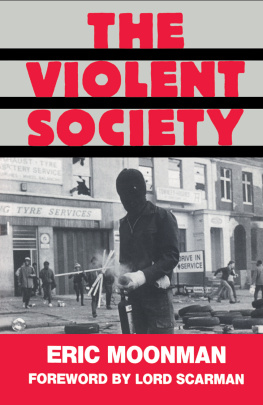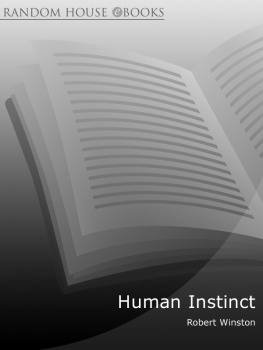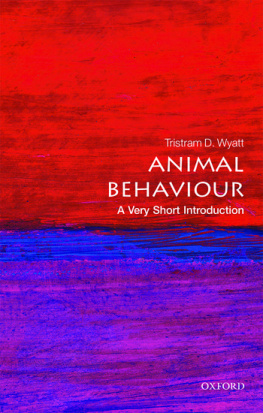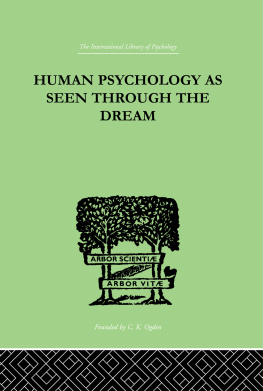THE VIOLENT SOCIETY
THE VIOLENT SOCIETY
Edited by
ERIC MOONMAN
Foreword by
LORD SCARMAN
First published 1987 in Great Britain by
FRANK CASS & CO. LTD.
Gainsborough House, Gainsborough Road
London E11 1RS, England
and in the United States of America by
FRANK CASS & CO. LTD.
c/o Biblio Distribution Centre
81 Adams Drive, P.O. Box 327, Totawa, N.J. 07511
Transferred to Digital Printing 2004
Copyright 1987 Frank Cass & Co. Ltd.
British Library Cataloguing in Publication Data
The violent society.
1. Violence
I. Moonman, Eric
303.62 HM281
ISBN 0-7146-3309-7
ISBN 0-7146-4055-7 Pbk
Library of Congress Cataloging in Publication Data
The Violent society.
1. Violence. I. Moonman, Eric.
HM291.V56 1987 303.62 86-26833
ISBN 0-7146-3309-7
All rights reserved. No part of this publication may be reproduced in any form or by any means, electronic, mechanical, photocopying, recording or otherwise, without the prior permission of Frank Cass and Company Limited.
CONTENTS
Lord Scarman
Eric Moonman
Geoffrey Pearson
Jane Moonman
Jim Patten
Richard Clutterbuck
Paul Wilkinson
Marcus Braybrooke
Each chapter of this work is in truth a separate essay or article in which an author distinguished in his field treats a different aspect or manifestation of violence in human society. I doubt whether so complete a treatise in so short a compass has been previously attempted.
The reader will be left in no doubt when he reflects on what he has read that violence is, and always has been, a feature or a threat in human society and will remain so.
The reason why this must be so is made plain in the early chapters. Violent behaviour is a display of mans aggressive instinct: without that instinct, which he (and she) shares with the rest of the animal kingdom, the human species would not survive.
On another level of debate it is also essential that a serious review should take place of the relationship between contemporary media and violence and this is to be found in the first chapter.
The challenge, therefore, to civilized mankind is not the elimination of violence but its control and restraint. And the lesson for a civilized society is that unless fear of attack, of deprivation, of frustration, is eliminated within a society the risk of violent outburst by those who see themselves as victims will be greatly enhanced. The problem is more than of maintaining law and order: it is also one of achieving a just society.
I have said enough to indicate that the subject of this anthology, though united in a single theme, is complex indeed. I cannot do better than invite you to read from cover to cover this challenging, exciting and sobering work.
Lord Scarman
Eric Moonman
Television and the other modern media have fulfilled a very positive function over the last decade or two in making more people aware of the wider world in which they live. News reporting of crises, from earthquakes to terrorist acts, may be witnessed on television within hours or even as they occur. The consequences of this presentation of world news as it is made is that images of violence are disseminated constantly and indiscriminately.
One aspect of violence, namely terrorism provides a vivid example of the negative effects of this phenomenon. Fringe groups, fanatics and their exploiters learn from the activities of their equivalents across the world. Defiance of the law and confrontation become commonplace a necessary part of extremist politics.
Assassinations, hijackings and riots have all taken place on television before an audience of millions. The issues become obscured by the sheer drama of the events being played out; frequency breeds contempt or, at the very least, indifference. Hijackings are still sufficiently rare to attract huge ratings; overturned cars, stone throwing and burning cars have become so familiar as to be boring. It is an appalling comment on contemporary society that matters which should revolt the consciousness have become models for the criminal, the terrorist and the desperate judged in terms of their entertainment value by the general public.
There is obviously a relationship between terrorism, small-scale war waged by bands of undisciplined recruits on civilian targets and regular wars between nation states fought with sophisticated and devastating weapons. Vietnam was the first war to be televised though it was not until the 1982 war in Lebanon that modern technology brought a war into our living rooms as it was happening. There is no question that this new dimension to warfare heightens international tension and stimulates the political debate surrounding any conflict. There are many ways in which this is a good thing but we should not blind ourselves to the dangers of the greater involvement of huge numbers of people through mass communications in international conflict. Violence is seen to be a necessary part of survival from the level of the local neighbourhood to the world arena. Neither should we ignore the enormous responsibility the whole phenomenon places on the media. Television cannot yet decide who wins a war but it can already decide who we think is winning.
On the other hand, consider the iniquities of the exclusion of the mass communications element. Look at the Soviet involvement in Afghanistan or the bloody and protracted conflict in the Gulf. Limited media access has not reduced the bloodshed or the injustice and has had the effect of producing amnesia among the general public.
The soviets calculated on a world that would lose interest in Afghanistan as the opportunities for the media to report were made virtually impossible. In fact, the reports that were allowed were usually stories of Soviet military successes or improvised informal reports from Western cameramen and reporters without Soviet permission. But a violent and brutal action was committed by a nation and it was, although to a limited extent, observed.
To the public, then, conditioning in terrorism has taken place whether by individual groups or superpowers. They have seen and they may well have experienced personally, some of these international disorders. In the United Kingdom a family on the mainland will know of the tension and terror experienced directly if they have family or friends living in Northern Ireland.
Along with the conditioning comes the direct personal experience. Whether it is mugging in your neighbourhood; a burglary of an old age pensioner with precious little to take; a hit-and-run driver who wrecks a family by killing a father or child. Or the soccer hooligan who terrorised the streets at Luton (before the cup tie with Millwall in the Spring of 1985) both before and after the game. It is all seen, felt, personally. No longer is it a detached film on T.V. It is here and now with terrible consequences for families, in which the destroyers have no respect for age or children nor circumstances.
What the chapters in this book will seek to examine is the connection between this type of violence, warfare and terrorism, and whether measures taken to curb or even eradicate the phenomenon in the domestic context will have any effect at the other end of the scale. Does one feed the other?
Is violence an inevitable, even necessary part of human existence? If so, can ways be found of channelling it into constructive as opposed to destructive activity? It turns out that the basic question with which we are concerned centres on the difference between aggression and violence, life-giving energy and death-dealing force. Thus we have moved from the specific to the general, from the pragmatic to the philosophical, an inevitable process if this collection of essays is to throw any light at all on the nature of contemporary violence.








